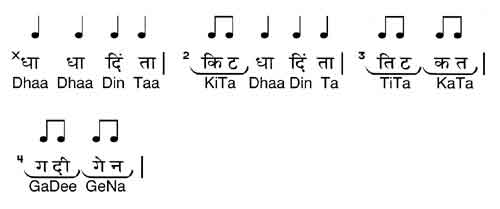Description
Chautal, variously referred to as Chartal, Chowtal, and even occasionally as Dhrupad tal, was a very common tal in the past. The names Chautal, Chowtal, and Chartal all mean “four claps”; this is a reference to the four claps of its vibhag structure. A few musicians refer to this tal as Dhrupad tal. Although this is a considerably less common name, it clearly refers to its strong usage in the dhrupad tradition.
Chautal has 12 matras. But this is the only thing that we can say with absolute certainty about its structure.
There seems to be some disagreement as to the vibhag arrangement. One school of thought contends that it consists of four vibhags of 4, 4, 2, and 2 matras respectively. According to this school, Chautal has only claps and no waves of the hand. Therefore, each of the four claps corresponds to a vibhag. This is the version that is shown below. There is another school which suggests that the structure of Chautal is the same as Ektal. Therefore, it would be viewed as six vibhags of two matras each. According to this school, the vibhags are clap, wave, clap, wave, clap, clap.
One should also bear in mind that the term “chowtal” is used in the Caribbean for a style of song. There is no connection between the chowtal of India and the chowtal found in Trinidad and Tobago
Chautal is strongly linked to the pakhawaj tradition; this has profound practical and theoretical implications. It is performed in a very heavy, powerful manner which is in sharp contrast to the more delicate style of the tabla. Furthermore, there are difficulties when we speak of the theka. Where modern tabla players use the theka as the defining characteristic of the tal, pakhawaj players of old used the clapping / waving arrangement. Many suggest that the term “thapi” should be used instead of “theka” as an indication of this fundamental conceptual difference.
The fact that there is not really a “theka”, but instead a “thapi” has tremendous practical importance. It is very normal for pakhawaj players to freely improvise in the middle of accompaniment. There is not the pressure to constantly play a simple “theka”. This constant free improvisation may be at times disorienting to the modern concert goer who is used to the theka for the accompaniment of kheyal, dadra, thumri and other contemporary classical forms.
Chautal tends to be played in the medium tempos only. One almost never hears extremely fast (ati-drut) or extremely slow (vilambit) performances.
Below are the characteristics of Chautal:
Clapping/ Waving Arrangement
clap 2, 3, 4, clap, 2, 3, 4, clap, 2, clap (disputed)
Number of Beats
12
Theka

Popular Songs
| IF YOU ARE INTERESTED IN TABLA, THIS BOOK IS FOR YOU |
|---|
This is the second volume of the most complete series on the tabla. Advanced Theory of Tabla It is available around the world. Check your local Amazon for pricing. |
